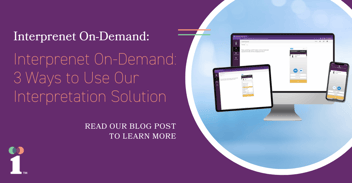
Is Over-The-Phone Interpretation (OPI) the only on-demand interpreting solution? It’s a question worth exploring.
Telephonic interpretation, also known as Over-The-Phone Interpretation, has been around for decades. While the technology behind OPI platforms has evolved significantly, the concept of OPI is still the same. You call a toll-free number, ask for a live interpreter in the language you need, and you are instantly connected. What could be more instantaneous than that?
To ensure immediate availability, OPI providers hire a high volume of remote interpreters who stand by ready for the next call. Billing is typically by the minute and quite cost-effective. OPI is the ideal interpretation solution for routine medical appointments, 911 emergencies, and any non-technical matters.
Are there other solutions for on-demand interpreting besides OPI?
Video Remote Interpretation (VRI) is also an on-demand interpretation service. With VRI, interpreters and clients see each other on video. This is beneficial for interpreting nonverbal communication, making VRI ideal for American Sign Language (ASL) as well. However, OPI is considered more "on-demand" because it is available in hundreds of languages. The largest VRI providers cover less than 40 languages. Some VRI languages must be scheduled in advance as there may not be enough video-supported interpreters available to guarantee on-demand service.
Do all other forms of interpretation require prescheduling?
Yes, and for good reason. On-demand interpreting services work best for general topics that don’t require as much specialization. Court and conference interpreters, for example, require unique certifications and skills such as the ability to interpret consecutively, simultaneously, and do even sight translation of documents. These interpreters are in high demand and in short supply. Since they are not readily available, you must reserve them ahead of time for your meeting.
The good news is that prescheduling of specialized interpreters is becoming more of an “on-demand” service. By using in-house interpreters and more efficient scheduling of interpreters, some leading providers can confirm orders for technical or simultaneous interpreters with less than a day’s notice. This works well for most clients who, like interpreters, need to prepare in advance for a successful meeting. An added benefit of prescheduling interpreters is that you can use any meeting platform of your choice. With OPI and VRI, on the other hand, you must use the provider’s platform.
Can AI facilitate an on-demand interpretation experience?
OPI, VRI, and prescheduled solutions rely on human interpreters to do the work. In comparison, AI systems using Automatic Speech Recognition (ASR) and machine translation offer limited solutions for on-demand customer support and live chat. However, they are not suitable for full-scale communication exchanges.
In conclusion, OPI is really the only true on-demand interpretation service. VRI follows close behind and, like OPI, is particularly useful in business-to-consumer settings, such as parent-teacher meetings and medical appointments that are relatively brief and predictable. In business-to-business settings requiring specialized interpreters to accurately cover financial, legal, or scientific topics, to name a few, prescheduled interpretation services are the way to go.
Want to discuss your next multilingual project and learn which solution is best for your needs? Contact our expert team!


%20(1).png?width=352&name=Blog%20Featured%20Images%201200%20x%20627%20(1)%20(1).png)